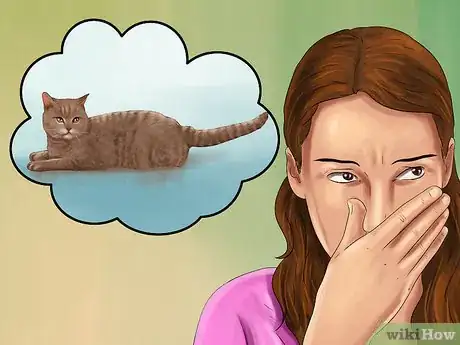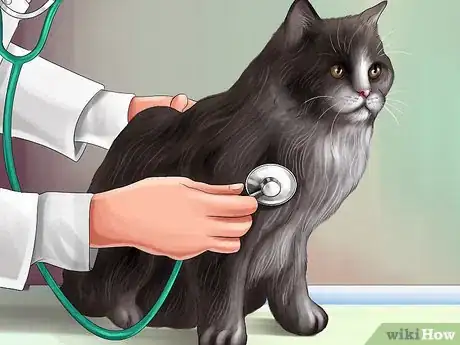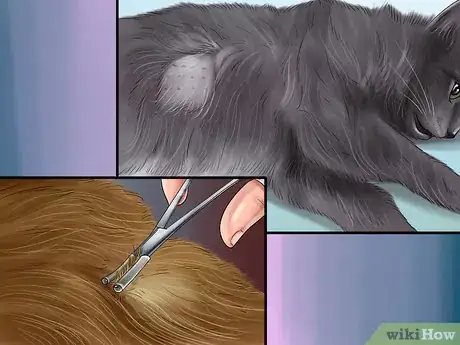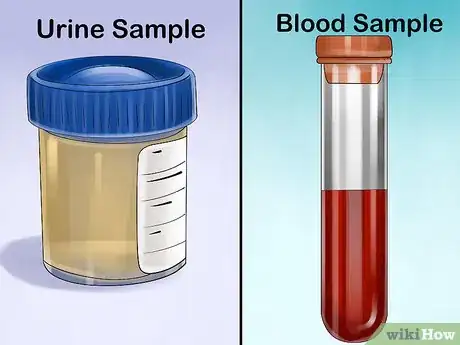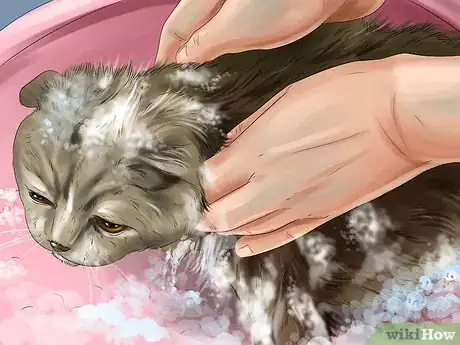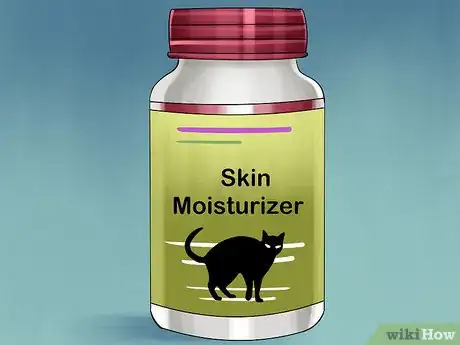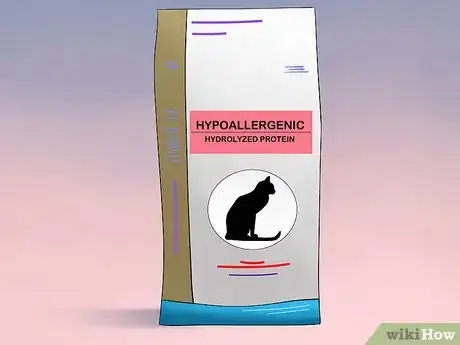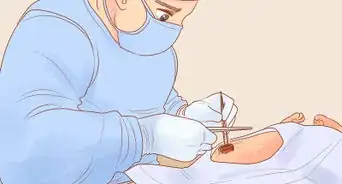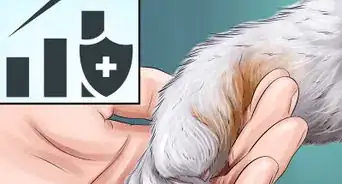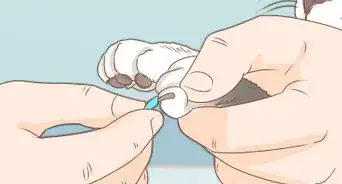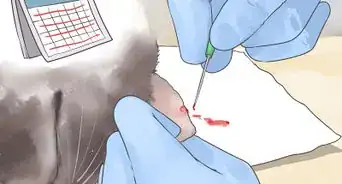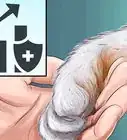This article was co-authored by Lauren Baker, DVM, PhD. Dr. Lauren Baker is a Veterinarian and Assistant Scientist at the University of Wisconsin-Madison. With over 10 years in veterinary medicine, she specializes in the concept of “one health,” which uses insights from veterinary medicine to help human medical research. She holds a Ph.D. in Comparative Biomedical Sciences, a Doctor of Veterinary Medicine, an MS in Comparative Biomedical Sciences, and a Bachelor’s degree in Psychology from the University of Wisconsin-Madison.
There are 7 references cited in this article, which can be found at the bottom of the page.
This article has been viewed 14,833 times.
In cats, seborrhea (similar to dandruff) is typically "secondary" seborrhea. That means that it indicates an underlying condition. It's a symptom rather than the disease itself. Occasionally, cats have primary seborrhea, meaning they have a genetic disposition to seborrhea without an underlying condition. However, that is more rare.[1] Therefore, you do want to treat the symptoms of the condition, but you also need to treat whatever is causing the condition.
Steps
Looking for Symptoms
-
1Check for oiliness. Cats who have seborrhea oleosa, the "oily" type of seborrhea, will often have oily skin. Their fur may even be oily. Cats who have the "dry" type of seborrhea, seborrhea sicca, will have dry skin.[2]
- However, some cats will have a combination of the two.
-
2Watch for flaking skin. Seborrhea is basically cat dandruff. Therefore, you'll likely notice flakes of skin in the cat's fur, particularly along the back. You may also notice the flakes where the cat has been sleeping.[3]
- The flakes are often bigger in the oily type of seborrhea than in the dry type.
Advertisement -
3Give your cat a sniff. Cats with seborrhea sicca (dry type) generally will smell normal. However, cats with the oil type will usually have a bad smell to their skin. If you notice an odor coming from you cat along with the flakes, it's more likely the cat has seborrhea oleosa.[4]
-
4Notice itching. Often, cats with seborrhea will have extreme itchiness. You may notice the cat scratching more often, as it tries to flake off the dead skin. The underlying condition may also cause itchiness.[5]
-
5Pay attention to inflamed skin. Seborrhea can also lead to inflammation on the skin, making it red and swollen. If your cat's skin has lesions or redness, that could be seborrhea. Check any skin folds on your cat, like in its armpits, neck, thighs, and belly, in particular.[6]
Diagnosing Seborrhea
-
1Watch for a physical examination. The first thing the vet will do is examine your cat, looking at the problem areas. This step helps the vet determine whether the problem is seborrhea or some other skin condition.[7]
-
2Be ready for a skin scrape test. One of the primary forms of diagnosis for this condition is the vet taking a scrape of skin for examination. This test will help establish whether your cat has an underlying problem.[8]
- A skin scrape is when the vet scrapes at the top of the skin from different areas of your cat. They may also do a skin biopsy, where the vet will take a bit more skin, though still a small amount.
- This test can check for bacteria, parasites, and fungi.
-
3Be prepared for your vet to do bacterial or fungal cultures. Ringworm is a leading cause of seborrhea in cats. To test for ringworm, your vet may take a sample of your cat's skin and fur and test it for fungal growth. The culture will also help your vet identify any bacterial infections your cat has developed.[9]
-
4Expect blood and urine tests. While your vet doesn't need a blood test to diagnose seborrhea itself, it's important to establish your cat doesn't have an underlying problem. Some underlying conditions include hyperthyroidism and/or Cushing's disease.[10]
- The urine and blood tests will also help the vet determine if your cat has any other imbalances that may be the problem.
Treating Primary and Secondary Seborrhea
-
1Shampoo your cat. Shampooing your cat can help in both dry and oily cases of seborrhea. However, you'll need to use different kinds of shampoos, depending on the type. For dry seborrhea, you'll need to use a moisturizing shampoo. For oily seborrhea, you'll need to use benzoyl peroxide or coal tar. Your vet can tell you what shampoo is best, as well as how often you'll need to bathe your cat.[11]
- Some cats are more tolerant of shampoos than others. You may need to try a few different shampoos to find one that's good for your cat.
-
2Consider a moisturizer. Moisturizing your cat's skin can provide some relief, particularly for dry seborrhea. Talk to your vet about a good moisturizer for your cat. You don't want to just slather on any lotion you have, as your cat will want to lick that off its skin.[12]
-
3Try a hypoallergenic diet. Sometimes, seborrhea is caused by allergies. Often, the allergen in question is the cat's food. Switching to a hypoallergenic cat food can help prevent allergic reactions. You may need to try a couple of foods before finding the right one.[13]
-
4Ask about supplements. Dietary supplements like omega-3 fatty acids may help your cat's condition. These supplements contribute to healthy skin and coat, which is what alleviates some of the problem. Talk to your vet about whether your cat needs a supplement or not.[14]
-
5Treat the skin infection. Infections on the skin can be what causes seborrhea. In that case, your cat may need an antibiotic or an antifungal medication to help treat the condition. This action may remove what's causing the problem.[15]
-
6Treat other underlying conditions. Because seborrhea can develop from any number of conditions, treating the underlying problem can sometimes help treat the skin condition. Talk to your vet about the best plan of action if your vet finds an underlying condition.[16]
- Some other common underlying conditions include hyperthyroidism, allergies, environmental causes, and pain in the muscles or skeleton. Because the causes are so varied, the cat needs to be diagnosed and prescribed treatment by a vet.
References
- ↑ http://www.merckvetmanual.com/integumentary-system/seborrhea/overview-of-seborrhea
- ↑ http://www.vetstreet.com/care/seborrhea-in-cats-and-dogs
- ↑ https://vcahospitals.com/know-your-pet/seborrhea-in-cats
- ↑ http://www.merckvetmanual.com/integumentary-system/seborrhea/overview-of-seborrhea
- ↑ http://www.pethealthnetwork.com/cat-health/cat-diseases-conditions-a-z/seborrhea-cats
- ↑ https://vcahospitals.com/know-your-pet/seborrhea-in-cats
- ↑ https://www.vetary.com/cat/condition/seborrhea
- ↑ http://www.merckvetmanual.com/integumentary-system/seborrhea/overview-of-seborrhea
- ↑ https://vcahospitals.com/know-your-pet/seborrhea-in-cats
- ↑ http://www.merckvetmanual.com/integumentary-system/seborrhea/overview-of-seborrhea
- ↑ https://www.vetary.com/cat/condition/seborrhea
- ↑ https://vcahospitals.com/know-your-pet/seborrhea-in-cats
- ↑ http://www.vetstreet.com/care/seborrhea-in-cats-and-dogs
- ↑ https://www.vetary.com/cat/condition/seborrhea
- ↑ http://www.merckvetmanual.com/integumentary-system/seborrhea/overview-of-seborrhea
- ↑ https://vcahospitals.com/know-your-pet/seborrhea-in-cats
About This Article
If you've noticed symptoms of seborrhea in your cat, like excessively dry or oily skin, flaking skin, bad odor, itching, or red and swollen skin, take it to a vet so they can help you figure out what's going on. The vet will do a physical exam and a skin scrape test, where they'll test your cat's skin for bacteria, parasites, and fungus. They might also run blood and urine tests to see if your cat has any underlying conditions that are causing its skin problems. If your cat does have seborrhea, you might need to give it antibiotics or other medications to get rid of any skin infections. You can also bathe your cat using special shampoos and apply moisturizers to help with dry skin, which your vet can recommend to you. Since seborrhea is sometimes caused by allergies, talk to your vet about switching your cat to a hypoallergenic diet as well. For advice on how to treat the underlying causes of seborrhea, scroll down.


